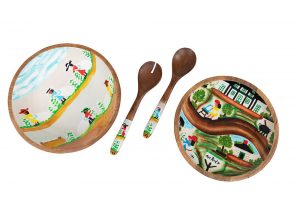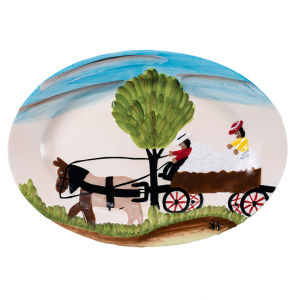See Serving Pieces Featuring Folk Art at Atlanta Market
By Mary Kuder
Doug Gitter, Founder of Gitter Gallery in Metairie, Louisiana, began learning about and collecting American southern folk art in the 1980s; it soon became his passion. In those days, the days before cell phones and global positioning satellites, Gitter would get in his car, head to nearby towns, find the local church, and ask townspeople where to find local artists. He would get directions, and then drive to meet these artists, usually in their own homes. It was in that way that he discovered the art of Clementine Hunter.
Already a collector of the work of other American folk artists, Gitter was moved by the work of this self-taught memory artist; her work was full of bold colors and depicted people engaged in the activities of everyday life on a plantation after the turn of the century. He began collecting some of her original works, thought to number between 5,000 and 10,000 pieces. Initially, he displayed these pieces in his Metairie home near New Orleans. However, in 2005, when flood damage from Hurricane Katrina caused the loss of several pieces from his personal collection, he decided he wanted to find a way to share this once-affordable art with as many people as possible – to make it affordable again.
 Gitter explained that Hunter’s artwork “resonates with end-users because Hunter’s passion flows through her artwork to the end-user: it’s from the heart, it’s emotional, it speaks to you.” Gitter decided that Hunter’s artwork “is an important part of American history and needs to be shared.” Thus, he founded Gitter Gallery in 2006, and then spent the next six years developing and designing the Clementine Hunter Collection. This collection includes tabletop ceramic service platters and bowls, dinnerware (10-inch plates), and 14-ounce mugs. Each piece of this collection is individually hand-molded and hand-painted so that it is a unique work of art that can be displayed on a wall or shelf, used as a tabletop centerpiece or used as serving pieces for any occasion.
Gitter explained that Hunter’s artwork “resonates with end-users because Hunter’s passion flows through her artwork to the end-user: it’s from the heart, it’s emotional, it speaks to you.” Gitter decided that Hunter’s artwork “is an important part of American history and needs to be shared.” Thus, he founded Gitter Gallery in 2006, and then spent the next six years developing and designing the Clementine Hunter Collection. This collection includes tabletop ceramic service platters and bowls, dinnerware (10-inch plates), and 14-ounce mugs. Each piece of this collection is individually hand-molded and hand-painted so that it is a unique work of art that can be displayed on a wall or shelf, used as a tabletop centerpiece or used as serving pieces for any occasion.
 Gitter Gallery houses and displays hundreds of pieces of Hunter’s work, and a significant portion of Gitter’s profits go to renovating, restoring, interpreting, and maintaining the house Hunter lived in within Melrose Plantation so that it looks just as it did before she died in 1988.
Gitter Gallery houses and displays hundreds of pieces of Hunter’s work, and a significant portion of Gitter’s profits go to renovating, restoring, interpreting, and maintaining the house Hunter lived in within Melrose Plantation so that it looks just as it did before she died in 1988.
So, just who was Clementine Hunter to garner all this attention?
“Clementine Hunter is to Southern contemporary folk art what Mickey Mouse is to Disney,” Gitter said. Born into a Creole family just two decades after the Civil War ended, and before the Second Industrial Revolution spread to Louisiana and the rest of the American South, Hunter spent her entire life working on either a farm or a plantation. She experienced the local economy move from a rural, agriculture-based economy with no mechanization, no electricity and no running water to an economy based on the growth of industries, and the expansion of electricity, petroleum and steel. “Her whole way of life changed over her lifetime,” Gitter said.
Hunter began working as a farm laborer while still a child and had little formal education, never learning to read or write; she learned to speak English only after her family moved from the farm to Melrose Plantation when she was a teenager and after she began working in the main house, cleaning and cooking.
Melrose Plantation housed on its grounds not only the plantation workers, but also several artists under the directive to produce or leave. When she was in her 50s, Hunter discovered some old paints and brushes left behind by one of these artists and began painting. She used bright, bold colors to depict people in the community involved in the activities of everyday life on a plantation: baptisms in the Cane River, weddings, funerals, washing day, horse-drawn wagons hauling cotton to the gin and tending the flower garden – featured are zinnias, Hunter’s favorite flower.
In the early years, Hunter allowed people to come into her home at Melrose Plantation and view her artwork for 5 cents; she sold some of her early work for 25 cents. However, by the 1940s, Hunter was becoming more well-known and was selling her artwork for $5 to $10 per painting. She was a prolific painter, creating more than 5,000 pieces of art between the 1930s and her death on January 1, 1988. She worked on the plantation by day and, according to The Shreveport Times, which published an article about her on September 27, 2018, painted at night while “perched on a low wooden stool, beside a quaint pot-bellied stove, as she held a homemade plywood palette in one hand and a brush [in the other] to create her paintings in oil.” She continued to work on Melrose Plantation right up until her death at the age of 101.
By the time of her death, Hunter’s artwork had been (and continues to be) displayed in museums and galleries around the world, including the Louvre in France, the Smithsonian in Washington D.C., the Minneapolis Institute of Art, and the American Folk Art Museum in New York. At the time of her death, original pieces of her artwork were selling for tens of thousands of dollars.
In spite of her success, however, Hunter was quite humble. To illustrate, Gitter tells a story about the time that then-President Jimmy Carter invited her to be his and Rosalynn’s guest during the time her work was on display in Washington D.C. Hunter thought about it for a while, and then responded, “If he wants to sees me, he knows where I lives.” In spite of her fame, during her lifetime Hunter never traveled outside her native state of Louisiana.
Hunter is now considered a pioneer among American southern contemporary folk artists and is Louisiana’s most famous artist. Through the efforts of Doug Gitter and others, her home on Melrose Plantation is now a museum and displays some of her artwork, including several murals housed on the second floor of the house. Hunter’s home, a four-room cabin, is also listed on the National Register of Historic Places. Gitter notes that it is the only African-American residence to be so listed.
Gitter Gallery continues to honor Hunter with its Clementine Hunter line of ceramics and, as of November 2019, a new line of mango wood serving pieces. As with the ceramic pieces, each is handcrafted: each piece has a unique surface, with the interior lined with food-grade enamel. They also, like the ceramic pieces, are individually hand-painted by an artist who recreates and brings alive the bold colors and passionate scenes of everyday life on Melrose Plantation.
Gitter will be bringing pieces from the entire Clementine Hunter collection (both ceramic and mango wood, as well as some textile pieces) to The Atlanta International Gift & Home Furnishings Market, where they can be seen January 15-19 on the second floor of Building 2, adjacent to the escalators. For more information, email doug@gittergallery.com or doug@gittergallery.com or visit www.gittergallery.com.

You must be logged in to post a comment.